PORSCHE 911 GT3 2013 6.G Information Manual
Manufacturer: PORSCHE, Model Year: 2013, Model line: 911 GT3, Model: PORSCHE 911 GT3 2013 6.GPages: 49, PDF Size: 22.75 MB
Page 11 of 49
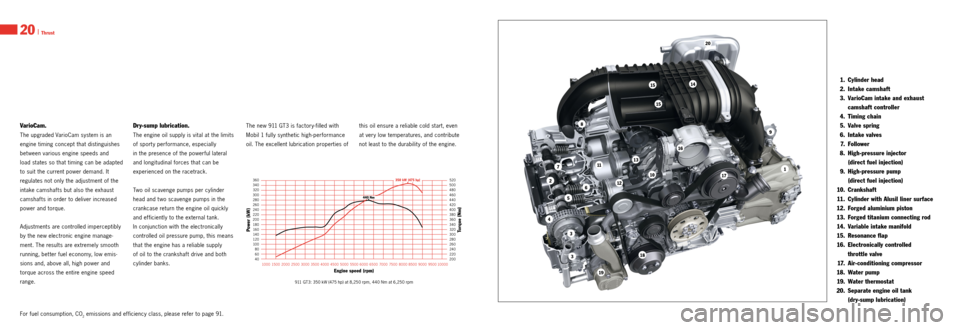
1
2
3
3
4
5
6
7
8
9
10
11
12
13
1415
15
16
17
18
19
20
1
2
3
3
4
5
6
7
8
9
10
11
12
13
1415
15
16
17
18
19
20
VarioCam.
The upgraded VarioCam system is an
engine timing concept that distinguishes
bet ween various engine speeds and
load states so that timing can be adapted
to suit the current power demand. It
regulates not only the adjustment of the
intake camshafts but also the exhaust
camshafts in order to deliver increased
power and torque.
Adjustments are controlled imperceptibly
by the new electronic engine manage
ment. The results are extremely smooth
running, better fuel economy, low emis
sions and, above all, high power and
torque across the entire engine speed
range.
Dry-sump lubrication.
The engine oil supply is vital at the limits
of sporty performance, especially
in the presence of the powerful lateral
and longitudinal forces that can be
experienced on the racetrack.
Two oil scavenge pumps per cylinder
head and t wo scavenge pumps in the
crankcase return the engine oil quickly
and efficiently to the external tank.
In conjunction with the electronically
controlled oil pressure pump, this means
that the engine has a reliable supply
of oil to the crankshaft drive and both
cylinder banks. The new 911
GT3 is factory filled with
Mobil 1 fully synthetic high performance
oil. The excellent lubrication properties of this oil ensure a reliable cold start, even
at ver y low temperatures, and contribute
not least to the durabilit y of the engine.
1. Cylinder head
2. Intake camshaft
3. VarioCam intake and exhaust
camshaft controller
4. Timing chain
5. Valve spring
6. Intake valves
7. Follower
8. High-pressure injector
(direct fuel injection)
9. High-pressure pump
(direct fuel injection)
10. Crankshaft
11. Cylinder with Alusil liner surface
12. Forged aluminium piston
13. Forged titanium connecting rod
14. Variable intake manifold
15. Resonance flap
16. Electronically controlled
throttle valve
17. Air-conditioning compressor
18. Water pump
19. Water thermostat
20. Separate engine oil tank
(dry-sump lubrication)
For fuel consumption, CO2 emissions and efficiency class, please refer to page 91.
911 GT3: 350 kW (475 hp) at 8,250 rpm, 440 Nm at 6,250 rpm
360
340 320
300 280260 240
220
200 18 016 0
14 0
120 10 0 8060
40
1000 15 0 02000 25003000 35004000 45005000 55006000 65007000 7500 80008500 9000 950010000 520
500
480 460
440 420
400 380360
340 320
300 280260 240
220
200
Torque (Nm) Power (kW)
Engine speed (rpm)
440 Nm
350 kW (475 hp)
20 I Thrust
Page 12 of 49

Intake manifold.
In interaction with the sports exhaust
system, the plastic variable intake manifold
helps to ensure efficient gas cycles and
high throughput.
To guarantee high torque and power
across a broad engine speed range,
the conventional distributor pipe in the
new 911 GT3 is supplemented by a
resonance pipe with resonance flap. This is opened or closed depending on
the engine speed. For optimum cylinder
charge.
This results in an impressive torque
curve, a high maximum torque and
ultimate power output across a broad
engine speed range.
Sports exhaust system.
The sports exhaust system of the new
911
GT3 has t wo front silencers, t wo
catalytic converters and one rear silencer,
which discharges into the central twin tract
tailpipes. The large volume of the exhaust
system reduces exhaust backpressure and
thus increases power output.
The t wo Lambda sensors of the stereo
Lambda control circuitry regulate the composition of the exhaust gas separately
in each exhaust tract, while another
pair monitors pollutant conversion in the
respective cataly tic converters.
Thrust I 23
For fuel consumption, CO2 emissions and efficiency class, please refer to page 91.
Page 13 of 49
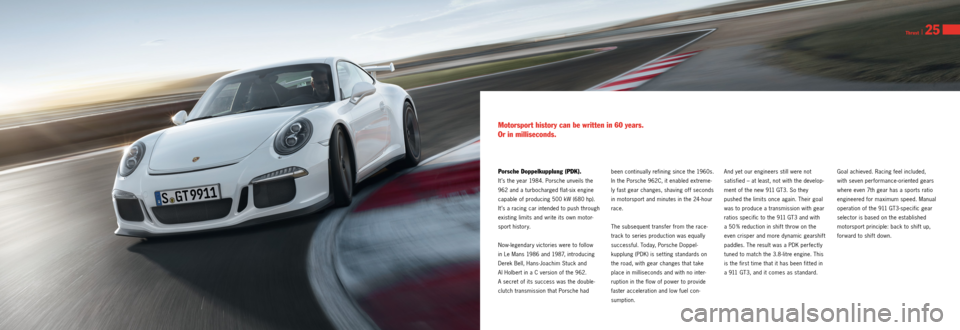
Porsche Doppelkupplung (PDK).
It ’s the year 1984. Porsche unveils the
962 and a turbocharged flatsix engine
capable of producing 500 kW (680 hp).
It ’s a racing car intended to push through
existing limits and write its own motor
sport histor y.
Now legendar y victories were to follow
in Le Mans 1986 and 1987, introducing
Derek Bell, Hans Joachim Stuck and
Al Holbert in a C version of the 962.
A secret of its success was the double
clutch transmission that Porsche had
Motorsport history can be written in 60 years.
Or in milliseconds.
been continually refining since the 1960s.
In the Porsche 962C, it enabled extreme
ly fast gear changes, shaving off seconds
in motorsport and minutes in the 24 hour
race.
The subsequent transfer from the race
track to series production was equally
successful. Today, Porsche Doppel
kupplung (PDK) is set ting standards on
the road, with gear changes that take
place in milliseconds and with no inter
ruption in the flow of power to provide
faster acceleration and low fuel con
sumption. And yet our engineers still were not
satisfied – at least, not with the develop
ment of the new 911 GT3. So they
pushed the limits once again. Their goal
was to produce a transmission with gear
ratios specific to the 911 GT3 and with
a 50 % reduction in shift throw on the
even crisper and more dynamic gearshift
paddles. The result was a PDK perfectly
tuned to match the 3.8 litre engine. This
is the first time that it has been fit ted in
a 911 GT3, and it comes as standard. Goal achieved. Racing feel included,
with seven performance oriented gears
where even 7th gear has a sports ratio
engineered for maximum speed. Manual
operation of the 911 GT3 specific gear
selector is based on the established
motorsport principle: back to shift up,
forward to shift down.
Thrust I 25
Page 14 of 49
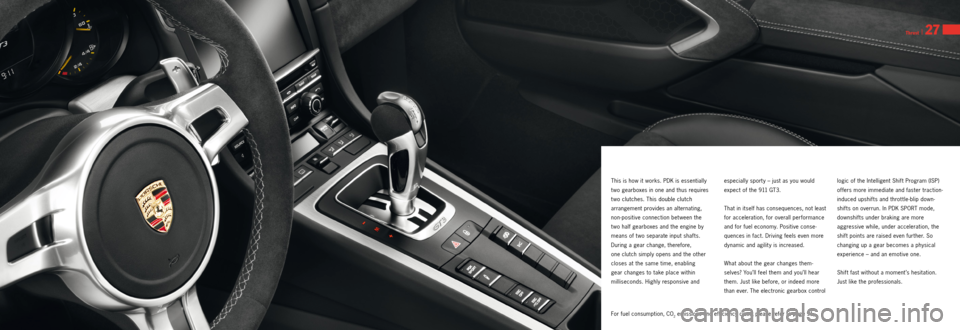
Thrust I 27
This is how it works. PDK is essentially
t wo gearboxes in one and thus requires
t wo clutches. This double clutch
arrangement provides an alternating,
nonpositive connection between the
t wo half gearboxes and the engine by
means of t wo separate input shafts.
During a gear change, therefore,
one clutch simply opens and the other
closes at the same time, enabling
gear changes to take place within
milliseconds. Highly responsive and especially sport y – just as you would
expect of the 911
GT3.
That in itself has consequences, not least
for acceleration, for overall performance
and for fuel economy. Positive conse
quences in fact. Driving feels even more
dynamic and agilit y is increased.
What about the gear changes them
selves? You’ll feel them and you’ll hear
them. Just like before, or indeed more
than ever. The electronic gearbox control logic of the Intelligent Shift Program (ISP)
offers more immediate and faster traction
induced upshifts and throttle blip down
shifts on overrun. In PDK SPORT mode,
downshifts under braking are more
aggressive while, under acceleration, the
shift points are raised even further. So
changing up a gear becomes a physical
experience – and an emotive one.
Shift fast without a moment ’s hesitation.
Just like the professionals.
For fuel consumption, CO
2 emissions and efficiency class, please refer to page 91.
Page 15 of 49
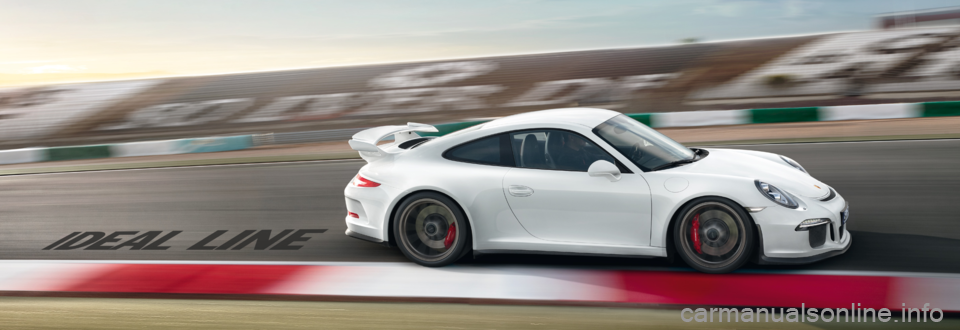
Page 16 of 49
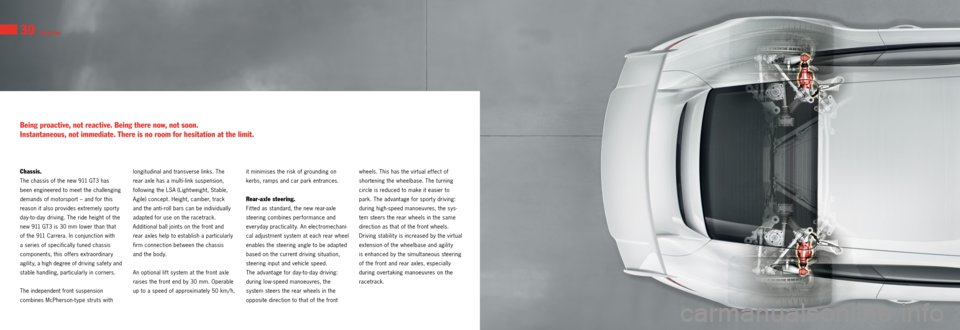
30 I Ideal line
Chassis.
The chassis of the new 911 GT3 has
been engineered to meet the challenging
demands of motorsport – and for this
reason it also provides extremely sport y
day to day driving. The ride height of the
new 911 GT3 is 30 mm lower than that
of the 911 Carrera. In conjunction with
a series of specifically tuned chassis
components, this offers extraordinary
agilit y, a high degree of driving safet y and
stable handling, particularly in corners.
The independent front suspension
combines McPherson type struts with
Being proactive, not reactive. Being there now, not soon.
Instantaneous, not immediate. There is no room for hesitation at the limit.
longitudinal and transverse links. The
rear axle has a multi link suspension,
following the LSA (Light weight, Stable,
Agile) concept. Height, camber, track
and the anti roll bars can be individually
adapted for use on the racetrack.
Additional ball joints on the front and
rear axles help to establish a particularly
firm connection between the chassis
and the body.
An optional lift system at the front axle
raises the front end by 30 mm. Operable
up to a speed of approximately 50 km/ h, it minimises the risk of grounding on
kerbs, ramps and car park entrances.
Rear-axle steering.
Fit ted as standard, the new rear
axle
steering combines performance and
everyday practicality. An electromechani
cal adjustment system at each rear wheel
enables the steering angle to be adapted
based on the current driving situation,
steering input and vehicle speed.
The advantage for day to day driving:
during low speed manoeuvres, the
system steers the rear wheels in the
opposite direction to that of the front wheels. This has the virtual effect of
shortening the wheelbase. The turning
circle is reduced to make it easier to
park. The advantage for sport y driving:
during high
speed manoeuvres, the sys
tem steers the rear wheels in the same
direction as that of the front wheels.
Driving stabilit y is increased by the virtual
extension of the wheelbase and agilit y
is enhanced by the simultaneous steering
of the front and rear axles, especially
during overtaking manoeuvres on the
racetrack.
Page 17 of 49
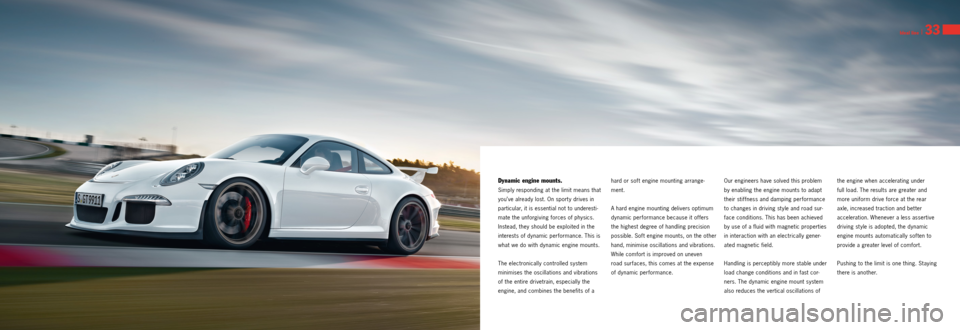
Ideal line I 33
Dynamic engine mounts.
Simply responding at the limit means that
you’ve already lost. On sport y drives in
particular, it is essential not to underesti
mate the unforgiving forces of physics.
Instead, they should be exploited in the
interests of dynamic per formance. This is
what we do with dynamic engine mounts.
The electronically controlled system
minimises the oscillations and vibrations
of the entire drivetrain, especially the
engine, and combines the benefits of a hard or soft engine mounting arrange
ment.
A hard engine mounting delivers optimum
dynamic performance because it offers
the highest degree of handling precision
possible. Soft engine mounts, on the other
hand, minimise oscillations and vibrations.
While comfort is improved on uneven
road surfaces, this comes at the expense
of dynamic performance. Our engineers have solved this problem
by enabling the engine mounts to adapt
their stiffness and damping performance
to changes in driving st yle and road sur
face conditions. This has been achieved
by use of a fluid with magnetic properties
in interaction with an electrically gener
ated magnetic field.
Handling is perceptibly more stable under
load change conditions and in fast cor
ners. The dynamic engine mount system
also reduces the vertical oscillations of the engine when accelerating under
full load. The results are greater and
more uniform drive force at the rear
axle, increased traction and better
acceleration. Whenever a less assertive
driving st yle is adopted, the dynamic
engine mounts automatically soften to
provide a greater level of comfort.
Pushing to the limit is one thing. Staying
there is another.
Page 18 of 49

Wheels and tyres.
Twent y inches instead of the 19 on the
predecessor model. Another improvement
to dynamic performance that brings you
closer to the sport y limit. The wheels
are platinum coloured and made from a
forged alloy.
The central locking device with ‘GT3’ logo
is derived from motorsport. Compared
with the conventional five bolt wheel con
nection, it offers enhanced performance
thanks to the reduction in rotating masses.
And, of course, it ensures a faster wheel
change, which is vital when you’re in the
pit and the clock is ticking. Tyre sizes are 245/35 ZR 20 on
9 J x 20 at the front and 305/30 ZR 20
on 12 J x 20 at the rear.
Road legal sports t yres on the new
911 GT3 help to provide the grip it
needs. Bear in mind, however, that the
reduced tread depth increases the
risk of aquaplaning on wet surfaces.
Tyre Pressure Monitoring (TPM) is fit ted
as standard in the new 911 GT3. Not only
does it send warnings to the on board
computer’s display screen in the event
of a gradual or sudden loss of pressure,
it also features a racetrack mode. This
takes into consideration the pressure and temperature characteristics of the t yres
on the circuit and precisely monitors
the pressure set in each individual t yre.
In other words, TPM is designed around
your sporting passion.
Porsche Active Suspension
Management (PASM).
This electronic active damping system
offers continuous adjustment of the
damping force on each wheel based on
the current driving situation and your
driving st yle.
At the press of a but ton, you can select
bet ween t wo different modes. ‘Normal’
mode is designed for sport y driving on
public roads and on wet racetracks.
‘Sport ’ mode is specially tuned for
maximum lateral acceleration and offers
the best possible traction on the track.
Ideal line I 35
Page 19 of 49

Ideal line I 37
Porsche Stability Management (PSM).
PSM is an automatic control system for
providing stabilit y at the limits of dyn
amic driving performance. In addition to
the anti lock braking system, it includes
Electronic Stability Control (ESC) and
Traction Control (TC).
Sensors continuously monitor the direc
tion, speed, yaw velocit y and lateral
acceleration of the car. Using this infor
mation, PSM is able to calculate the
actual direction of travel at any given
moment. If the car begins to oversteer or
understeer, PSM applies selective braking
on individual wheels to restore stabilit y. What ’s special about PSM in the new
911
GT3? The systems intervene at the
limits of dynamic driving performance
with exceptional sensitivit y and precision.
In addition, the systems can be complete
ly deactivated in t wo stages for deliber
ately sporty handling.
Porsche Torque Vectoring Plus
(PTV Plus).
Porsche Torque Vectoring Plus is fit ted as
standard and has been specially adapted
to the new 911 GT3. It operates in con
junction with an electronically regulated
and fully variable rear differential lock.
Numerous driving parameter inputs are the basis for the system’s active control
outputs. The results are perceptible, par
ticularly at the limits of dynamic perfor
mance: greater traction, increased lateral
dynamics and a significant improvement
in driving stabilit y under the effects of
load changes in corners and when the car
changes lane. On surfaces with less grip,
such as in the wet, the system strategically
brakes the right or left rear wheel. This
means that, whenever the car enters a
corner, brake pressure is applied to the
inside rear wheel. Consequently, a greater
amount of drive force is distributed to the
outside rear wheel. This improves steering
behaviour and increases agility. In combination, both aspects of PT V Plus
offer tangible benefits, giving you
unrivalled pleasure at every t wist and
turn. It ’s just as well there happens
to be so many waiting on the racetrack.
Page 20 of 49
